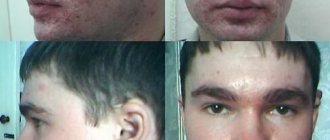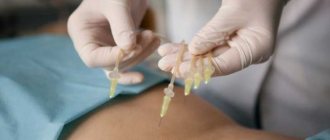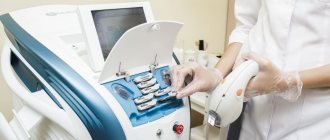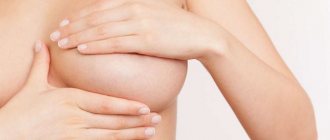Hyperhidrosis is one of the most pressing problems in modern cosmetology. Normally, profuse sweating occurs in the event of intense physical activity or a strong increase in temperature. However, if even an ordinary leisurely walk leads to the fact that all your clothes are covered with unsightly wet spots or you sweat a lot from the slightest stressful situation, you can confidently speak about hyperhidrosis.
Treatment in the field of hyperhidrosis has today made a big step forward: truly effective means have appeared that can block increased sweating for a long time, and in some cases completely relieve the patient of such a problem.
It is important to understand that sometimes hyperhidrosis is a consequence of a serious disease associated with the endocrine or nervous system. Therefore, before contacting various centers for the treatment of hyperhidrosis, you should consult a doctor - your problem may require drug treatment. If everything is fine with your health and hyperhidrosis is simply a feature of your body that causes you a lot of inconvenience, then our clinic can offer you several options for eliminating it.
How does hyperhidrosis manifest?
Hyperhidrosis is a pathological condition accompanied by increased sweating of the whole body (generalized form) or individual parts of it (idiopathic form) - armpits, feet, palms, large skin folds in obesity. Local forms of hyperhidrosis are much more common.
Sweating is an important physiological process necessary for:
- thermoregulation of the body;
- maintaining water-salt balance;
- regulation of metabolism and removal of toxins.
Sweat is secreted onto the surface of the skin by special exocrine glands, which are located over almost the entire surface of the body (with the exception of the genitals). Sometimes in some areas they begin to work with abnormal intensity as a result of non-compliance with personal hygiene rules or the presence of certain diseases. The activity of these glands is regulated by the sympathetic nervous system.
Nervous tension, fear, and aggression can provoke so-called emotional hyperhidrosis. Exertion in such states leads to the production of adrenaline. At the same time, the heart rate increases, the pupils dilate, and the body, as it were, prepares to meet a possible threat. This is a natural process established by nature.
Recommended articles on the topic:
- Body treatments for skin tone and weight loss
- Stone massage: description, benefits, methods
- Weight correction: everything you need to know about the procedure
In such a situation of increased activity, more intensive cooling is required, and the sweat glands are activated. To get rid of sweating due to nervousness, it is enough to try to normalize your psychological state. The occurrence of hyperhidrosis in a calm mood serves as a signal of the disease, so before starting treatment it is necessary to determine the cause of this phenomenon. Elimination of the existing etiological condition in most situations helps to get rid of hyperhidrosis without the use of laser therapy.
Causes of increased sweating can be:
- Disturbances in the functioning of the nervous system, stress, etc.
- Endocrine abnormalities (increased levels of thyroid hormones, diabetes mellitus, postmenopausal syndrome, etc.).
- Acute infectious diseases and chronic (tuberculosis, influenza, sore throat, etc.).
- Rheumatism.
- Genetic diseases.
- Emotional overload.
- Taking medications that affect the autonomic nervous system (for example, antidepressants, Propranolol, Acyclovir, aspirin, etc.).
- Tumor diseases.
- Drug and alcohol addiction.
This list of reasons should be supplemented with physiological factors that trigger the process of sweating to maintain normal body temperature. These include increased air temperature, physical activity, emotional stress or stressful situations, and consumption of hot food and drinks.
It is also worth not forgetting about conditions unrelated to your state of well-being. These include:
- Use of synthetic clothing out of season.
- Failure to comply with hygiene procedures.
- Using narrow shoes made of rubber or artificial leather.
Among other things, increased sweating can be hereditary. In such situations, hyperhidrosis manifests itself already in childhood in the absence of any concomitant and provoking pathologies.
Read material on the topic:
Anti-wrinkle facial massage
What degree is there?
Hyperhidrosis of the head and face manifests itself under certain conditions, but if left without adequate treatment, the disease can become chronic.
In this case, treatment will be very long and difficult. As soon as the first signs of the disease appear, that is, a mild degree begins, this usually occurs against the background of severe stress, you should immediately consult a doctor.
In medicine, there are 2 main types of hyperhidrosis:
- idiopathic;
- secondary.
In the first case, the pathology manifests itself against the background of stress, lack of sleep, old age and a number of other provoking factors. But in fact, this type of disease does not have a specific cause or nothing is known about it yet.
In the case of secondary hyperhidrosis, it is a little clearer. It can be caused by thyroid dysfunction, diabetes mellitus, vegetative-vascular dystonia and other systemic diseases. That is, it is a complication of a chronic disease or condition. For example, during pregnancy, women often experience increased sweating (read more about the causes of excessive sweating in women and ways to solve the problem here).
Advantages and disadvantages of laser treatment for hyperhidrosis
Treatment of hyperhidrosis of the feet and other areas with laser has a huge number of advantages. Firstly, this is the duration of the effect of this method. Laser therapy permanently eliminates excessive sweating in 80% of cases within 4–7 weeks. More severe situations require repeating the procedure after a few months.
In addition to high efficiency, the advantages of laser treatment for hyperhidrosis include:
- Minimal trauma to the skin, since the operation is performed using a minimally invasive method.
- There is absolutely no risk of infection.
- The procedure is carried out without anesthesia, only with local anesthesia.
- No recovery period in a clinical setting.
- The laser beam does not leave scars, hematomas, burns, etc.
- Slows the growth of unwanted hair in the treated area.
- Favorable effect on the condition and appearance of the skin.
Alas, there is no method that provides a 100% guarantee that a repeat procedure will not be required. Experts openly say that the effect of laser treatment for hyperhidrosis is not guaranteed and there are situations when it does not give the desired result even after the second application. At the same time, Botox injections or iontophoresis create better dryness compared to this method.
Reviews about the treatment of underarm hyperhidrosis with laser are mostly only good. It is this zone that is most often identified by patients for treatment. But today not all clinics provide laser treatment for hyperhidrosis of the palms and feet.
The disadvantages of this procedure include:
- High price.
- The level of professionalism of the doctor performing the procedure must be quite high.
- The recovery period is accompanied by swelling, pain and bruising.
Read material on the topic:
Myostimulation of body muscles
How is therapy carried out?
Getting rid of hyperhidrosis using a laser device is done as follows:
- The specialist makes several small punctures in the skin into which the optical fiber is inserted. It is important to note that these piercings do not leave any scars or scars.
- Destruction of sweat glands with a laser beam. Since the specialist has the ability to control the depth and power of the beam, adjacent healthy tissues are not affected or injured.
- The doctor applies a bandage impregnated with an antiseptic to the skin where the manipulations were performed. The patient will need to wear it for 4 days.
What is the essence of laser treatment for hyperhidrosis?
This method involves exposing the problem area to a diode laser, which destroys most of the sweat glands, and they are not restored in the future.
In addition, its rays simultaneously destroy hair follicles, which allows you to get rid of unwanted hair in the armpit area.
The operation is carried out in a completely sterile room in compliance with all sanitary standards.
Doctors do not recommend removing all sweat glands in the problem area. They play an important role in the thermoregulation of the body, and this can lead to the development of the problem of compensatory sweating (hyperhidrosis in other areas of the body), as well as excessive dryness of the epidermis, etc.
The process itself begins with testing to determine the degree of sweating. This is done through the Minor test. This is a special iodine-starch test, in which Lugol's solution or iodine solution is applied to the skin with a swab, and then sprinkled with starch. Iodine interacts with starch when sweat appears, and a dark blue color occurs, and in places of the most significant accumulation of sweat glands, the skin becomes almost black. It is these areas that are subject to the most thorough treatment.
The procedure begins with anesthesia of the area where laser treatment will take place, and this is perhaps the most uncomfortable moment. Then the doctor makes three small two-millimeter incisions in the skin, through which a flexible tube with a laser optical fiber inside is inserted. Thanks to this, the bases of the sweat glands are destroyed, but the effect is only in the fatty area and does not affect neighboring tissues and vessels.
If the specialist is not professional enough, very minor burns may still remain on the skin. After the end of the laser treatment, a small “scraper” is inserted into the punctures and the inner surface of the canals is scraped out with it. This manipulation helps prevent the breakdown of scorched sweat glands, which will be accompanied by the release of toxic products. The resulting material is removed outside.
The entire procedure, including the preparatory stage, lasts about an hour, after which a special bactericidal bandage is applied to the injured area to restrain skin movement. It must be worn for several days.
The patient, as a rule, can leave the clinic almost immediately after carrying out all the necessary manipulations and observing the body’s reaction. He can return to his normal lifestyle, with the exception of some restrictions, which we will discuss below.
Read material on the topic:
Manual therapy of the cervical spine - features of the technique
Removal of sweat glands: radical treatment of hyperhidrosis
A neat appearance allows you to feel confident in any life situation, but neither new clothes nor neat makeup and hairstyle can cope with excessive sweating. Is it possible to get rid of this feature of the body?
Surgical removal of sweat glands in the armpits, palms and soles of the feet is a radical and effective way to forget about hyperhidrosis and related problems. How are such operations performed, to whom are they indicated, and do they always provide the desired result? Are there any contraindications, complications or side effects? TecRussia.ru shares information:
↑ In what cases should sweat glands be removed?
- Normally, sweating protects us from overheating. This is one of the ways to detoxify the body and regulate water-salt metabolism. Once the need for cooling subsides or homeostasis is restored, our skin becomes dry again. This process is regulated by the autonomic nervous system, or, to be precise, by its sympathetic part, which is responsible for the functioning of the body in a stressful situation.
- Deviations in its functions lead to the fact that the slightest excitement or worry provokes the release of huge amounts of sweat from the secretory cells. Scientists have not yet figured out exactly why such failures occur. Some experts are inclined to the genetic theory, others argue that the leading role belongs to an excessive number of stressful situations in a person’s life, while others advocate the influence of the endocrine system.
Regular profuse sweating, which does not depend on the effects of physical or psychological factors on the body, is called hyperhidrosis. This pathology has two forms:
- Generalized - most often accompanies infectious or oncological diseases, as well as endocrine disorders, disappears after the causes are eliminated.
- Local - develops due to dysfunction of the ANS and practically does not respond to conservative therapy.
The favorite affected areas for PH are the palms, feet and armpits. It is with them that cosmetologists and surgeons work. Moreover, often the former are quite enough: injections of botulinum toxin into the problem area can quickly and easily get rid of excess moisture for up to 6 months. However, not all patients receive the full effect from injections and not everyone is satisfied with the need to regularly repeat the procedure.
↑ Options for surgery to remove sweat glands
There are several ways to surgically remove sweat glands:
- Skin excision is the most traumatic option, in which the surgeon cuts out a large area in the armpit area and then sutures it. As a result, sweat production actually stops, since all secretory cells and excretory ducts are removed along with the tissues, but instead, patients are left with rough scars, and hand movements become difficult due to skin tension. Currently, due to the large number of complications, this method is not used.
- Liposuction of the armpits is precisely this operation that is most often meant when people talk about laser removal of sweat glands. Although, it can be performed in other ways: classic vacuum aspiration, as well as more modern ones - radio waves, ultrasound, etc. It is the splitting and subsequent pumping out of local deposits of subcutaneous fat, during which a significant part of the sweat glands is also removed and the nerve endings associated with them are destroyed. It is rarely performed in isolation; in most cases, this operation is combined with liposuction of other parts of the body. It is indicated only for hyperhidrosis of the armpits, since, unlike the palms and feet, the secretory cells here are located deep in the subcutaneous fat layer, which makes it possible to destroy them without injuring the dermis.
- Armpit curettage. The principle of this operation is not much different from liposuction: the same removal of fat from the secretory glands and traumatization of the nerve endings occurs. The main difference is that during the curettage process, the inner side of the skin is also peeled off from the adipose tissue and, accordingly, the sweat ducts contained in it. The result of such an intervention will be the destruction of more than 90% of the sweat glands that are located in the treated area of the body, as well as the absence of nervous regulation of the remaining elements. Initially, the operation was performed mechanically, using a curette - an instrument in the shape of a sharp spoon, which is where it got its name. Later, modern aspiration, laser and ultrasound methods were developed.
- Endoscopic thoracic sympathectomy is a high-tech method based on blocking nerve impulses. Allows you to neutralize sweat glands not only in the armpits, but also on the palms and soles of the feet. During the operation, the surgeon, through small incisions in the intercostal space, gains access to the sympathetic nerve trunks, which are “responsible” for sweating. Next, a special titanium clip is applied to them, blocking the transmission of impulses: as a result, hyperhidrosis stops in 90-95% of cases. Another group of such nerves is located in the lumbar region and regulates exclusively the sweating of the feet - you can also work with it if the problem is localized only in the lower extremities. Another big advantage of sympathectomy is its reversibility. If the patient experiences unpleasant side effects (for example, compensatory hyperhidrosis), the clip can always be removed, returning the nerve channels to their original state.
↑ What should the patient prepare for?
During the initial consultation, the surgeon conducts a thorough examination, determines the presence/absence of contraindications or conditions that may negatively affect the result of removal of sweat glands. Since armpit curettage, liposuction, and sympathectomy are invasive techniques, standard preoperative tests will be required:
- blood – general and biochemistry;
- urine - general
- coagulogram;
- fluorography or radiography of the chest organs;
- ECG.
If the chosen intervention option requires general anesthesia (usually it is used for sympathectomy and also for volumetric liposuction, when work is carried out not only on the armpits, but also on other parts of the body), the patient is also advised by an anesthesiologist.
Before the operation begins, the Minor test is mandatory - this is the so-called iodine-starch test. Its purpose is to determine clear boundaries of the area of increased sweating, which may differ markedly from patient to patient. To do this, a special Lugol's solution containing iodine is applied to the area under study. After the treated leather has dried, starch is sprayed on its surface: upon contact with the released sweat and iodine, it acquires a characteristic dark purple color.
The traumatic nature of the operation itself, as well as the duration and severity of the rehabilitation period depend on the chosen technique:
- Sympathectomy is considered the most gentle option: although it is usually performed under general anesthesia, which means you will have to spend the first day in a hospital, then the inconvenience and lifestyle restrictions are minimal.
- Liposuction and curettage of the armpits are more difficult to tolerate. For 2-3 weeks (sometimes up to several months), swelling and hematomas may persist in the intervention area. Surgical incisions heal after 3-4 days, and then thin scars, invisible from the outside, form in their place. Also, the patient may be prescribed antibacterial agents to prevent inflammatory processes. Bandaging of the axillary zones with elastic bandages during the first postoperative week is mandatory - this manipulation accelerates the regeneration of damaged tissues and prevents the development of complications.
↑ How effective is surgery to remove sweat glands?
Surgical methods for removing sweat glands do not provide a lifetime guarantee against hyperhidrosis, but in comparison with most conservative methods they are much more effective:
- Curettage and liposuction of the armpits significantly reduce sweating, but do not stop it completely. Also, six months to a year after surgery, in a significant proportion of patients (according to some estimates - up to 30%), it resumes - to a somewhat lesser extent, but still sufficient to create new problems with the quality of life. In this case, another similar operation is performed, during which most of the remaining secretory cells are removed. However, it happens that curettage is repeated 3-4 times, but hyperhidrosis does not disappear anywhere - in this case, it is worth paying attention to injection methods for treating this disease.
- Sympathectomy provides close to 100% effectiveness immediately after surgery. But here, too, there are often cases when, over the next 8-12 months, the functional activity of the sweat glands in patients is almost completely restored - due to the fact that nerve impulses “learn” to pass to their target along other, peripheral paths. This problem can also be solved by repeated clipping, which, however, does not completely exclude a new relapse.
↑ Contraindications, possible complications and side effects
Despite the low traumatic nature of the operations considered, all the main general surgical limitations remain:
- problems with the cardiovascular and other important systems of the body;
- oncological, immune and other serious diseases;
- pregnancy and lactation period;
- blood clotting disorder.
Since the removal of sweat glands is carried out primarily for therapeutic rather than aesthetic purposes, it is allowed to operate on patients under 18 years of age - but only if they suffer from severe hyperhidrosis, which is difficult to respond to conservative or injection treatment. And even in these cases, interventions are usually not prescribed before the age of 16.
As for undesirable consequences and side effects, they depend on the type of surgery performed:
- Any complications associated with surgical liposuction are possible (also relevant for curettage)
- The main problem of sympathectomy is the so-called. compensatory hyperhidrosis. This is a situation when, instead of neutralized ones, other areas of the body begin to sweat excessively - the stomach, back, chest, etc. If this problem is only mild, it may be enough for the patient to take medications that reduce general sweating. If the secretion in a “new way” is too intense, you will have to remove the previously installed clips and look for other treatment options - for example, botulinum toxin injections.
- Also, sometimes sympathectomy leads to other, sometimes quite unexpected, disorders caused by blocking nerve impulses. This may be ptosis of the eyelids, pain in the extremities, vasodilatation, etc. Fortunately, such problems are extremely rare and usually resolve within 6-8 months.
- What to do to avoid sweating? 10 ways to get rid of hyperhidrosis
- Damp problem: how to deal with sweat odor?
↑ How much does it cost to remove sweat glands? Current prices
Patient costs will depend on the type of surgery performed:
- Liposuction and curettage are the cheapest - their cost is calculated by zone, and one armpit is approximately equal to 1 zone. The average price is 15-25 thousand rubles.
- Sympathectomy costs significantly more – from 50 thousand rubles. This amount is due to the general high-tech nature of the intervention and the need to use expensive endoscopic equipment.
Recovery after laser treatment for hyperhidrosis
The use of a laser is a safe procedure and therefore does not have serious consequences associated with well-being after treatment.
Possible complications include the following:
- The appearance of bruises.
- Swelling.
- Temporary loss of sensation in the operated area.
- Unpleasant sensations.
- Allergy.
For the first five days, experts recommend applying an antiseptic bandage to the treated area. This can be a sterile gauze cloth, well secured with an adhesive plaster or bandage. It is necessary to ensure that the bandage does not come off during movements. During this period, it is better to avoid intense work and rubbing the skin of the armpits on clothing.
Within two to three weeks it is not recommended:
- Visit public swimming pools, baths and saunas.
- Remove hair from the laser treatment area.
- Use antiperspirant deodorants.
After laser therapy, the patient can immediately return to their normal lifestyle. The procedure is suitable for both men and women. The effect depends only on the characteristics of the patient’s body and the severity of hyperhidrosis.
Read material on the topic:
How to massage the abdomen for weight loss: different techniques for health and beauty
Diseases
Most pathologies associated with the activity of sweat glands are directly related to diseases. Pathologies are distinguished:
- Anhidrosis. A pathological condition when sweat is not produced. The disease in its acute form can be the result of intestinal infection with certain pharmaceutical substances, acute diseases of an infectious nature, or pregnancy. Long-term health problems are determined by the underdevelopment of specific nerve elements or due to disorders of the skin structure;
- Oligohidrosis. Decreased sweating due to a decrease in the number or functional weakness of sweat glands. The disease often appears in elderly patients;
- Hyperhidrosis is an increased level of sweat production. There are two varieties. General sweating is expressed by the uncontrolled release of sweat over the entire plane of the body, and the localized type is high sweating of individual elements of the body (the area under the armpits, palms, soles of the feet).
Increased sweating can be observed in people with the following pathologies:
- With an increase in thyroid activity;
- Pathology caused by Koch's bacillus;
- Neuroses;
- Dermatosis affecting mainly the skin;
- Chronic inflammatory skin disease of allergic nature.
Possible complications after laser treatment of hyperhidrosis and contraindications
Some patients notice enlarged lymph nodes after surgery. This is possible if the lymphatic system was affected during the procedure. This complication goes away within a month.
Sometimes there is a decrease in skin sensitivity in the armpits. This is a reversible reaction caused by the destruction of nerve endings by a laser scalpel.
The lack of effectiveness of such treatment for hyperhidrosis in some cases can be explained by the anatomical features of the body, which is capable of partially restoring the destroyed sweating system. In such cases, symptoms return a few weeks after surgery.
If a specialist prescribes laser treatment for excessive sweating, there is no need to refuse: this therapy is not dangerous, painless, and the positive result will be dry armpits and feet, which will no longer cause an unpleasant odor.
To avoid serious negative consequences, contraindications to the procedure should be taken into account.
The main contraindications for laser treatment of sweating include:
- Age up to 18 years.
- Inflammatory processes of the sweat or sebaceous glands in the area of interest.
- Dermatological diseases, allergic rashes in the intended area of influence.
- Acute infections.
- Oncological diseases.
- Diabetes mellitus in the stage of decompensation.
- Blood diseases, bleeding disorders.
- Pregnancy and lactation period.
- Regular use of certain medications (to reduce blood clotting, steroid hormones, and drugs with a photosensitizing effect).
Components included in medications can provoke the occurrence of photosensitivity. A list of such drugs can be found in open medical publications. Some of the most common in this category are antibiotics, anti-inflammatory drugs, and hormonal contraceptives.
Read material on the topic:
Manual therapy of the cervical spine as a worthy replacement for alternative treatment
How to diagnose?
Diagnosis of hyperhidrosis is a complex of instrumental and laboratory studies.
- First of all, the doctor collects an anamnesis, during which the patient’s age, lifestyle, diet, habits and the presence of chronic diseases are revealed.
- Then an external examination of the patient is carried out, the condition of the skin on his face and head, and the lymph nodes in the neck and armpits are palpated, so the doctor determines whether they are enlarged or not. The patient also undergoes urine and blood tests.
- During an instrumental examination using an ultrasound machine, the condition of the thyroid gland and pelvic organs is studied. X-ray allows you to find pathologies in the chest.
- If there are prerequisites for this, the doctor will prescribe a computed tomography scan of the organs of interest.
- It also happens that the problem can only be detected as a result of a complete magnetic resonance imaging.
How much does laser treatment for hyperhidrosis cost?
Today, laser treatment of armpit hyperhidrosis is the most effective among all possible methods of getting rid of sweating. Almost all cosmetology clinics in Russia and many more widely targeted private institutions are equipped with appropriate equipment and can provide laser therapy services.
The cost of treatment depends not only on the professionalism of the surgeon, the reputation of the center and the conditions of the operation, but also on the region. The average price for laser treatment of hyperhidrosis in Moscow is about 40 thousand rubles. In other regions, the cost of laser treatment for hyperhidrosis is somewhat cheaper - about 25-30 thousand rubles.
The result of therapy largely depends on the qualifications of the surgeon, so we strongly recommend that you contact doctors who have not only the appropriate certificate, but also certain experience. First study the reputation of the clinic, its specialists, the conditions for the procedure, and then make an appointment.
Nowadays, you no longer have to spend a lot of time performing complex and unpleasant procedures at home. It is much easier to seek help from real professionals - the Veronika Herba beauty and health center, equipped with effective and modern equipment.
Why clients choose Veronika Herba beauty and health center:
- This is a beauty center where you can undergo laser treatment for hyperhidrosis at a reasonable cost, while your body will be treated by one of the best specialists in Moscow. This is a completely different, higher level of service!
- You can receive qualified help at any time convenient for you. The beauty center is open from 9:00 to 21:00, seven days a week. The main thing is to agree with your doctor in advance on the date and time of your appointment.
Sign up for a consultation with a specialist by phone 8 (495) 995-15-13
, and you will see for yourself!
External remedies for excessive sweating
It should be emphasized that absolutely all conventional deodorants are intended for people with normal sweating. Let's analyze drugs developed specifically to combat hyperhidrosis.
Lassara paste (salicylic-zinc)
It contains salicylic acid, zinc oxide, starch and petroleum jelly. The first two elements actively reduce the number of microorganisms present in heavily sweating areas and causing an unpleasant odor. Starch absorbs excess moisture, normalizing skin condition. A course of salicylic-zinc ointment gives a pronounced anti-inflammatory effect, reduces tissue irritation and creates a protective barrier that prevents the appearance of fungus and infection.
Use DryDry to eliminate hyperhidrosis of the armpits, large skin folds, palms and feet
The paste should be applied to dry, clean skin in an even, thin layer. Depending on the complexity of the problem, the frequency of application varies from 2 to 4 times a day. Course duration is up to 1 month. Before use, consultation with your doctor is necessary, since Lassara paste has contraindications and quite serious side effects, including impaired liver and kidney function.
Teymurov paste (solidol ointment)
The main components: boric and salicylic acids, zinc oxide, aldehyde, lead acetate and talc. Pastes act as an antimicrobial, deodorizing and drying agent. Improves skin condition and reduces sweating, and this effect lasts even after the end of the course.
Teymurov's paste is applied to clean, dry skin 1 or 2 times a day. It is necessary to remember the side effects (almost the same as Lassara paste), so you should treat only small, most problematic areas of the skin. The full course of treatment does not exceed 1 week.
DryDry and other preparations with aluminum chloride hydrate
Aluminum chloride interacts with proteins and forms insoluble complexes that close the openings of the sweat glands, thereby preventing the release of sweat onto the surface of the skin. The most famous product is the DryDry deodorant from the Swedish concern Excelsior. In addition to aluminum compounds, it contains ethyl alcohol. It gives a drying and antiseptic effect.
Use DryDry to eliminate excessive sweating in the armpits, large skin folds, palms and feet. The result in the armpits is expected to last about a week, in other areas - less, since in such places the skin peels off much faster and is replaced with new one. The product is applied in a thin layer, like a regular deodorant. The most suitable time is the evening, since after application it is necessary to ensure complete rest for the treated area for several hours. In the morning you can already apply any other antiperspirant or perfume. DryDry does not cause problems with constant use. This fact is confirmed by clinical studies and customer reviews (the drug has been sold for more than 25 years).
Causes of hyperhidrosis
Pathological increased sweating is possible for a number of reasons, which include:
- Pathologies of the thyroid gland.
- Consequences of concussions and contusions of the brain.
- Metabolic diseases.
- Infectious diseases.
- Alcoholism and drug addiction.
- Allergic diseases.
- Psychasthenia (neurosis), etc.
Increased sweating of the head in men has the same reasons as increased sweating of the face in women.
We recommend studying the article on a similar topic “Excessive sweating in children” within the framework of this material.
Classification
Hyperhidrosis is divided into two types:
- Primary, when it appears unexpectedly and for no apparent reason.
- Secondary hyperhidrosis is associated directly with any pathological condition in the body. A wide range of neurological diseases, dermatological syndromes and medications can lead to the development of secondary hyperhidrosis.
Primary hyperhidrosis, like secondary hyperhidrosis, can be localized (one area of the body) or widespread.
Important! It is necessary to carry out timely differential diagnosis to identify the cause of the condition, since treatment of secondary hyperhidrosis according to the primary one is ineffective.
Excessive sweating of the head is called cranial hyperhidrosis; face - facial hyperhidrosis. The combination of these two types is craniofacial hyperhidrosis.
Excessive sweating can cause dizziness and other signs of vascular insufficiency











